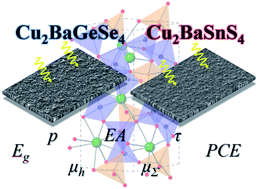Optoelectronic property comparison for isostructural Cu2BaGeSe4 and Cu2BaSnS4 solar absorbers†
Abstract
To target mitigation of anti-site defect formation in Cu2ZnSnS4−xSex, a new class of chalcogenides, for which Ba or Sr (group 2) replace Zn (group 12), has recently been introduced for prospective solar absorber application. Cu2BaGeSe4 (CBGSe) and Cu2BaSnS4 (CBTS) are two such compounds, which share a common trigonal crystal structure (P31 space group) and similar quasi-direct band gap (∼2 eV). While CBTS-based films have already been studied, there are no reports yet on films and solar cells based on related CBGSe. To identify key differences and similarities in the electronic properties between these two materials, electronic characteristics (e.g., carrier concentration, mobility, electron affinity, defect levels, recombination, and charge carrier kinetics) of vacuum-deposited CBGSe and CBTS films are compared using a variety of characterization methods. Hall effect measurements reveal that CBGSe films have relatively higher hole carrier concentration and lower mobility (3 × 1015 cm−3, 0.6 cm2 V−1 s−1) compared to CBTS (5 × 1012 cm−3, 3.5 cm2 V−1 s−1). Photoelectron spectroscopy yields low electron affinity values for both CBGSe (3.7 eV) and CBTS (3.3 eV), pointing to the necessity of pursuing low electron affinity buffer materials for both types of absorbers. At low temperatures, CBGSe films show free-exciton photoluminescence, as well as pronounced deep-level emission at ∼1.4 eV, while CBTS films exhibit a strong bound-exciton signal with noticeably less intense deep-level emission than for CBGSe. Charge carrier kinetics, transport, and recombination properties of both types of films are also analyzed using optical-pump terahertz-probe spectroscopy and time-resolved microwave conductivity. The first CBGSe prototype solar cells (using chemical bath deposited CdS as a buffer layer) show a maximum of 1.5% efficiency with ∼0.62 V open-circuit voltage. The measured properties point to possible limiting factors for CBGSe and related films for PV and optoelectronics and provide insights on possible approaches for improvement within this multinary chalcogenide family.



 Please wait while we load your content...
Please wait while we load your content...